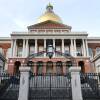1. A specter is haunting America – the specter of joblessness. Between Bill Clinton’s Washington exit 17 years ago and Donald Trump’s recent inauguration, about 10 million jobs across the nation have disappeared. Poof. Gone.
2. Friday’s report from the Department of Labor that the economy added 235,000 jobs is good news. “Robust,” is how NPR characterized it. But it’s a gloss on reality. It doesn’t reflect that somewhere between 20- and 40-million able-bodied people of working age have been displaced or dropped out of the workforce.
3. There are huge social, economic, and political implications attached to this still under appreciated phenomenon. The two most obvious: Brexit and Trump’s election. It would be gross over simplification to attribute these tectonic shifts to disappeared jobs alone. But it is reckless and irresponsible not to factor it into public thinking.
4. To understand how circumstances have changed, go back to 1992. James Carville led Clinton’s 1992 campaign to victory by zeroing in on how voters perceived the state of their pocketbooks. “The economy, stupid” was Carville’s shorthand. It worked. By the end of Clinton’s second term, about 20 million new jobs were created. Boston was particularly graced, enjoying the lowest unemployment in its history.
5. But things change. That jobs equal the economy is a very 20th century idea. Like the unemployment index, it’s out of date, old fashioned, quaint. Thanks to a cocktail of factors – deregulation, globalization, deindustrialization, automation – wealth in the 21st century has become uncoupled from work. Since the turn of the century, and in spite of the worst economic downturn since the Great Depression, the measure of American wealth doubled to $90 trillion. The bonanza, we know, nests among the already affluent.
6. This stark distribution of rewards disturbs many. But political economist Nicholas Eberstadt thinks even more unnerving, more perilous than broad-based income inequality is the widespread financial insecurity that springs from joblessness, which is the ultimate denial of social mobility.
7. “The year 2000,” Eberstadt writes in Commentary, “marks a grim historical milestone…for whatever reasons, the Great American Escalator, which had lifted successive generations of Americans to ever higher standards of living and social well being, broke down around then – and broke down very badly.”
8. Exhibit A: The opioid epidemic. Consider these numbers: during the heroin plague of the 1970s 1.5 people per 100,000 died of overdoses; crack in the 1980s claimed 2 per 100,000; opioids are today killing at a rate of 10.3 per 100,000. In New Hampshire, the death toll runs around 30 per 1000,000; in West Virginia, it's 40 per 100,000.
9. These numbers are drawn from Christopher Caldwell’s article “American Carnage” in First Things. Both Caldwell and Eberstadt are men of the non-Trumpian right. As I’ve read around on the issues of joblessness and addiction, it has struck me that some conservative writers have often been more penetrating than their opposites on the left because they are looking at the effect on society – as opposed to viewing things as a matter of policy. This particular strength brings with it a certain near sightedness. Because conservative writers and scholars are so committed to free-market capitalism, they tend not to push their thinking as far as they should. (Although Eberstadt’s implications are among the most radical I have found.)
10. As the history of the industrial revolution demonstrates, capitalism is a radically destabilizing force. And 21st century capitalism – with its natural corollary joblessness – creates wealth not on the backs of workers, but by marginalizing them. In tech talk, it’s disintermediation with a human face. It’s the unrecognized challenge of today. As Stephen Hawking, arguably one of the biggest brains alive, recently warned, “The rise of artificial intelligence is likely to extend this job destruction deep into the middle classes." In other words, we ain’t seen nothing yet.




